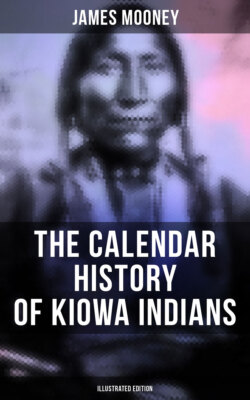Читать книгу The Calendar History of Kiowa Indians (Illustrated Edition) - James Mooney - Страница 11
На сайте Литреса книга снята с продажи.
Comparative Importance of Events Recorded
ОглавлениеTable of Contents
An examination of the calendars affords a good idea of the comparative importance attached by the Indian and by the white man to the same event. From the white man's point of view many of the things recorded in these aboriginal histories would seem to be of the most trivial consequence, while many events which we regard as marking eras in the history of the plains tribes are entirely omitted. Thus there is nothing recorded of the Custer campaign of 1868, which resulted in the battle of the Washita and compelled the southern tribes for the first time to go on a reservation, while the outbreak of 1874, which terminated in their final subjugation, is barely noticed. On the other hand, we find noted such incidents as the stealing of a horse or the elopement of a woman. The records resemble rather the personal reminiscences of a garrulous old man than the history of a nation. They are the history of a people limited in their range of ideas and interests, such materials as make up the chronicles of the highland clans of Scotland or the annals of a medieval barony.
It must be remembered, however, that an Indian tribe is simply a large family, all the members being interrelated; this is particularly true of the Kiowa, who number only about 1,100. An event which concerns one becomes a matter of gossip and general knowledge in all the camps and is thus exalted into a subject of tribal importance. Moreover, an event, if it be of common note in the tribe, may be recorded rather for its value as a tally date than for its intrinsic importance.
On this point Mallery says, speaking of the Lone-dog calendar, that it "was not intended to be a continuous history, or even to record the most important event of each year, but to exhibit some one of special peculiarity.... It would indeed have been impossible to have graphically distinguished the many battles, treaties, horse stealings, big hunts, etc, so most of them were omitted and other events of greater individuality and better adapted for portrayal were taken for the year count, the criterion being not that they were of historic moment, but that they were of general notoriety, or perhaps of special interest to the recorders" (Mallery, 1).
A brief interpretation of the calendars here described was obtained from the original owners in 1892. To this was added, in the winter of 1894—95, all that could be procured from T'ébodal, Gaápiatañ, ´dalpepte, Set-ĭmkía, and other prominent old men of the tribe, together with Captain Scott's notes and the statements of pioneer frontiersmen, and all available printed sources of information, including the annual reports of the Commissioner of Indian Affairs for more than sixty years. The Dohásän calendar is still in possession of Captain Scott. The Sett'an and Anko calendars are now deposited in the Bureau of American Ethnology.
